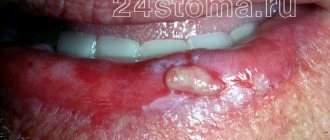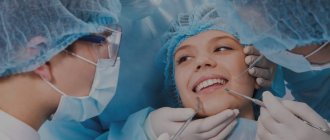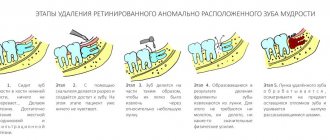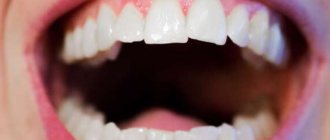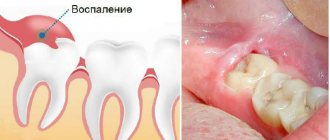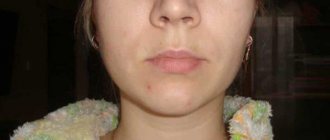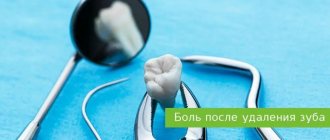Author of the article:
Soldatova Lyudmila Nikolaevna
Candidate of Medical Sciences, Professor of the Department of Clinical Dentistry of the St. Petersburg Medical and Social Institute, Chief Physician of the Alfa-Dent Dental Clinic, St. Petersburg
Let's figure out how to determine that gum inflammation has begun after tooth extraction, how to quickly get rid of it and prevent its occurrence.
Signs of normal wound healing
After a tooth is removed, a hole is formed in the empty area in which a natural blood clot accumulates. It is very important to monitor it closely. This substance must not be removed, scrubbed, washed or dissolved. A blood clot is the most reliable protection of a wound from infection and inflammation.
Gum restoration begins 3-4 days after tooth extraction. If the operation was traumatic, the healing process lasts 5-7 days. After removal of wisdom teeth (“eights”), the healing process can exceed 10 days. The back teeth are the most “complex”, as they have many canals, so after their removal the risk of gum inflammation is especially high.
Within 5-7 days after tooth extraction, a white film appears at the bottom of the empty socket. This film is an absolutely normal reaction of the body, as protective fibrin covers the wound from “attacks” of pathogenic organisms. Just like a blood clot, the film should never be processed.
The speed of healing of the hole depends on a number of factors:
- depth of the operation performed;
- localization of the focus of the operation;
- associated dental problems;
- the state of immunity and other characteristics of the patient’s body.
If the gums are swollen and begin to bleed within half an hour to an hour after tooth extraction, this is normal. However, if the inflammation does not subside within a few hours, be sure to contact your surgeon.
Types of inflammation
The most common types of inflammation that occur after tooth extraction are:
- Alveolitis is an inflammation of the walls of the empty socket of an extracted tooth. The patient suffers from swelling, redness, and “tugging” pain. Weakness, malaise appear, and body temperature rises.
- Gingivitis is inflammation caused by tooth extraction. The tissues turn red, begin to swell and bleed.
- Periostitis is an inflammation of the jaw bone (periosteum). The disease is characterized by severe toothache, swelling of the gums, gumboil, and distortion of the facial contour. Pathological mobility of the tooth appears, lymph nodes are palpated in the face and neck.
- Periodontitis is inflammation of the periodontium, the area around the root of the tooth. The disease is characterized by aching or sharp pain in the tooth, which intensifies when biting. Without treatment, the pain gradually turns into throbbing, tearing pain. The patient complains of severe weakness, fever, and sleep disturbances.
- Trauma to the gums from dental fragments. With mechanical damage to tissues, swelling, redness appear, and spontaneous pain begins, intensifying when touched. If the injury persists for a long time, a dark pressure ulcer with purulent and serous discharge may form at the site of injury.
Is it always necessary to remove a wisdom tooth?
No! A wisdom tooth can erupt without problems if there is enough space in the dentition. If it is correctly and evenly located in the dentition, does not injure the mucous membrane of the gums and cheeks, and does not injure the adjacent molar, then there is no need to remove it. This is a full-fledged tooth involved in the act of chewing.
Sometimes, after complete eruption, the wisdom tooth remains partially covered by the mucous membrane, a “hood”, under which bacterial plaque can accumulate. Due to poor hygiene in this area, inflammation of the gum covering the tooth may occur. If the gum above the wisdom tooth hurts, it is enough to simply remove it (remove the hood).
Any tooth in the oral cavity has its own antagonist, i.e. a similar tooth on the opposite jaw, with which they should close. This allows the teeth to participate in chewing and be cleaned while eating. Wisdom teeth often do not have antagonists (for example, the lower molars have erupted but the upper ones have not). In this situation, it is recommended to remove these teeth. Why? The fact is that if a tooth does not have an antagonist, it does not participate in the act of chewing and in the process of eating it will not be cleared of bacterial plaque and very quickly caries will form on it, which is very difficult to cure (for the patient, since it is necessary to very widely and keep your mouth open for a long time).
Preservation of a wisdom tooth and its treatment are possible in the absence of contraindications, good mouth opening and the patient’s strong desire.
One of the indications for preserving a wisdom tooth is the absence of the seventh or sixth teeth (first and second molars), removed in early childhood for various reasons. In this situation, the orthodontist can move the eighth tooth to the area of the missing ones, maintaining the continuity of the dentition. Moving teeth (especially chewing ones) is a long process. It is best to start it before the full eruption of the wisdom tooth.
Symptoms of inflammation
Inflammation of the gums after tooth extraction is indicated by the following symptoms:
- Bleeding from the wound. Even cold compresses do not stop the bleeding.
- Redness, swelling, pain in the gums that does not subside within 5-7 days after extraction.
- Throbbing sharp pain in the empty socket.
- Unpleasant putrid odor from the mouth.
- Discharge of pus from the wound, the resulting fibrous film becomes green.
- Numbness of the jaw, cheeks.
Individual oral hygiene after wisdom tooth removal.
- For 3 days, you should not rinse your mouth vigorously, as this can lead to sutures coming apart and bleeding;
- You should brush your teeth and tongue as usual twice a day, without touching the postoperative area with a toothbrush;
- After each meal, carefully rinse your mouth with a warm decoction of chamomile, sage, arnica or oak bark, which has a mild antiseptic and tannic effect. If you don’t have any decoctions on hand, you can use chamomile or regular black tea (a strong solution);
Treatment of inflammation
Treatment of gum inflammation after tooth extraction depends on the disease that arose during the operation. If a problem is suspected, the patient is advised to consult a doctor. An experienced dentist will determine the nature of the inflammation and prescribe proper treatment.
- In case of alveolitis, tissue curettage is performed, all contents are scraped out of the hole, and the tissues are sanitized. The doctor places a swab with an antiseptic on the wound.
- Periostitis is usually treated surgically. The doctor opens the rotting lesions and carries out medical treatment using anti-inflammatory, painkillers and antibiotics.
- Gingivitis requires the removal of tartar, normalization of oral hygiene and gum care using special rinses.
- For periodontitis, complex treatment is carried out using antibiotics, antiseptics, as well as anti-inflammatory and painkillers.
- Broken tooth fragments are removed by a surgeon; rinses, applications, and baths with antiseptics can be used to relieve inflammation.
Sometimes, for inflammation of the gums after tooth extraction, the patient is prescribed physiotherapeutic procedures, for example, exposure to a helium-neon laser, a course of fluctuarization. Also, gums can become inflamed after brushing your teeth.
With proper treatment of gum inflammation after tooth extraction, the socket is restored in about 10 days, and the outbreak itself disappears within two weeks.
Wisdom tooth.
The third molar, also known as the wisdom tooth, usually does not begin to emerge until age 17. If it has not appeared before the age of 25, then most likely it either does not exist at all, or it cannot squeeze into the dentition due to lack of space in it. The wisdom tooth becomes impacted.
Very often, a wisdom tooth cannot erupt because it is located perpendicular to the neighboring teeth, rests against them and pushes them. If a tooth cannot erupt for a long time, it is called impacted. Impacted wisdom teeth are often the cause of:
- Inflammation of the gums and the development of pericoronitis (inflammation of the gums overhanging the wisdom tooth);
- Caries of neighboring teeth, because the gap between an unerupted wisdom tooth and a healthy second molar is almost never cleaned when brushing your teeth and a large amount of bacterial plaque and food debris accumulate there;
- Development of an abscess in the retromolar region (the area behind the wisdom tooth)
First aid
If after tooth extraction there is mild inflammation and there is no suppuration, it can be removed at home and prevent the spread of discomfort.
- For 30 minutes after tooth extraction, do not remove the antiseptic tampon placed in the hole.
- Do not eat for 2 hours after removal.
- If there is bleeding after tooth extraction, apply a cold compress, such as an ice cube, to the gum.
If a doctor prescribes rinses for the treatment of inflamed gums, they should be done as carefully as possible. It is important not to wash the protective clot out of the hole. On the first day after surgery, you should avoid rinsing, and on the second day, use antiseptics and herbal decoctions.
During the healing period, it is also recommended to avoid food and drinks that are too cold or too hot, and never touch the socket with your fingers, toothpicks or other foreign objects.
A reliable rinse that will help eliminate gum inflammation is the ASEPTA ACTIVE mouth rinse. This unique two-component rinse with a combination of chlorhexidine + benzidamine has antimicrobial, anti-inflammatory and analgesic effects and provides an immediate anesthetic effect.
Preparing for wisdom tooth removal
Your surgeon will explain to you what needs to be done and how to prepare before tooth extraction. If you smoke, it is advisable to stop smoking one day before surgery, as this significantly reduces the likelihood of such complications after surgery as infection of the extracted tooth socket, which significantly lengthens the healing time of the postoperative wound. The result of wound infection is the development of inflammation and pain in the postoperative area.
If you plan to remove all your wisdom teeth under general anesthesia (anesthesia), the anesthesiologist will give recommendations on how to prepare for anesthesia. It is usually recommended not to eat or drink for about 8 hours before going into anesthesia.
If there is an inflammatory process in the area of the teeth that are supposed to be removed, the operation is usually postponed for several days until the inflammatory phenomena subside, antibiotics are prescribed and the area of inflammation is “washed” (under the hood) with antiseptic solutions
Folk remedies
Let's look at useful rinse recipes that are used to treat gingivitis and alveolitis after tooth extraction.
One tablespoon of dry crushed chamomile (sage, calendula) should be steamed with 250 ml of boiling water. The mixture should be left for an hour, wrapped in a towel, then filtered and used for rinsing. It is recommended to rinse your mouth every 2-3 hours.
The following healing recipes will help relieve inflammation and relieve discomfort:
- Mix 20 drops each of tea tree oil, cloves and liquid vitamins A and E, add a pinch of cayenne pepper. Moisten a cotton swab with the resulting medicine and apply it to the painful area.
- Wet baking soda with water to form a paste and apply it to the inflamed area.
ASEPTA gel with propolis will help you quickly cope with gum inflammation. This unique product containing the waste product of bees relieves inflammation of the gums by 31%, has anti-inflammatory, antimicrobial effects against gram-positive bacteria, as well as antipruritic and analgesic effects (reduces the pain of affected tissues), accelerates the process of regeneration and epithelization of wound surfaces, stimulates metabolic processes.
We hope that our recommendations for the treatment of gum inflammation after tooth extraction will be for informational purposes only. Treat yourself carefully and remember: at the first symptoms - acute pain in the gums, sudden changes in temperature, severe swelling of the gums, discharge of purulent exudate - consult a doctor as soon as possible. A lesion can be disastrous, so take care of yourself after surgery.
Sources:
- Clinical and laboratory assessment of the influence of domestic therapeutic and prophylactic toothpaste based on plant extracts on the condition of the oral cavity in patients with simple marginal gingivitis. Doctor of Medical Sciences, Professor Elovikova T.M.1, Candidate of Chemical Sciences, Associate Professor Ermishina E.Yu. 2, Doctor of Technical Sciences Associate Professor Belokonova N.A. 2 Department of Therapeutic Dentistry USMU1, Department of General Chemistry USMU2
- Clinical studies of antisensitive toothpaste “Asepta Sensitive” (A.A. Leontyev, O.V. Kalinina, S.B. Ulitovsky) A.A. LEONTIEV, dentist O.V. KALININA, dentist S.B. ULITOVSKY, Doctor of Medical Sciences, Prof. Department of Therapeutic Dentistry, St. Petersburg State Medical University named after. acad. I.P. Pavlova
- Comparative clinical evaluation of the effectiveness of treatment of traumatic lesions of the oral mucosa IORDANISHVILI A.K. *,** Doctor of Medical Sciences, Professor, Professor of the Department *Department of Orthopedic Dentistry of the Federal State Budgetary Educational Institution of Higher Education “North-Western State Medical University named after. I.I. Mechnikov" of the Ministry of Health of the Russian Federation (rector - Doctor of Medical Sciences Sayganov S.A.); **Department of Maxillofacial Surgery and Surgical Dentistry of the Federal State Budgetary Military Educational Institution of Higher Education “Military Medical Academy named after S.M. Kirov" of the Ministry of Defense of the Russian Federation (chief - Corresponding Member of the Russian Academy of Sciences, Professor A.Ya. Fisun).
- The role of anti-inflammatory rinse in the treatment of periodontal diseases (L.Yu. Orekhova, A.A. Leontyev, S.B. Ulitovsky) L.Yu. OREKHOVA, Doctor of Medical Sciences, Prof., Head of Department; A.A. LEONTIEV, dentist; S.B. ULITOVSKY, Doctor of Medical Sciences, Prof. Department of Therapeutic Dentistry of St. Petersburg State Medical University named after. acad. I. P. Pavlova
- Report on clinical trials of anti-inflammatory balm for gums "Asepta" adhesive, St. Petersburg State Medical University, 2007
- Report on determining/confirming the preventive properties of commercially produced personal oral hygiene products: Asepta toothpaste used in combination with Asepta mouthwash and Asepta gum balm Head. Department of PFS Doctor of Medical Sciences Professor S.B. Ulitovsky St. Petersburg State Medical University named after Academician I.P. Pavlova. Faculty of Dentistry. Department of Preventive Dentistry.
